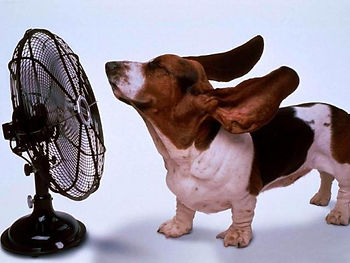Hotter Than Blue Blazes
“As the mercury rises to triple-digit temperatures in the middle of July, there is nothing better than relaxing in the comfort of an air conditioned home, or taking a dip in the swimming pool.” This is the opening line to a speech my daughter gave for FFA. She went on to say later in the speech that we Oklahomans are no strangers to extreme weather. Well, we are about to move into those blazing hot days of summer. So, now is a great time to talk about heatstroke and its prevention.
When heat production exceeds heat loss in the body, hyperthermia occurs, and hyperthermia can be divided into two categories. Pyrogenic hyperthermia is a fever, and this occurs because the temperature set point in the brain is reset. This usually occurs secondary to infection or inflammation. This can actually be protective. Non-pyrogenic hyperthermia is an elevated core body temperature that causes thermal injury to tissues. When a dog’s core body temperature is greater than 106°F, they are at risk of multi-system organ damage and/or death.

Unlike humans, dogs are unable to sweat. They rely on evaporation (panting), convection (cool air blowing over a surface), and conduction (transfer of heat to a cool surface) as methods of cooling. There are certain risk factors that decrease heat dissipation, including high humidity, confinement with poor ventilation, conformation (short noses in brachycephalic breeds of dog, i.e., pugs, Boston terriers, Boxers, bulldogs), and disease conditions that affect the respiratory system (laryngeal paralysis, collapsing trachea, and heart disease). Overweight dogs and geriatric dogs are also at greater risk of heatstroke. Increased heat production can be seen with exercise, seizures, and certain drug intoxications.
The early stages of heatstroke include panting, a rapid heart rate with bounding pulses, vomiting, diarrhea, dehydration, and depression. As heatstroke progresses, dogs will have severe respiratory distress with blue mucous membranes. They can develop small hemorrhages over their body. They may collapse. They can have bloody diarrhea, or they may vomit blood. Their pulses will weaken. Their temperature can normalize or even become subnormal. They can develop neurological signs such as seizures or even coma.

If you suspect that your dog is having heatstroke, they should be cooled immediately. Submerge them in cool water or ice water, and try to get a fan on them to aid cooling. Ideally, they should be taken out of the cool water once their body temperature is 103°F. They should be taken to a veterinarian for continued supportive care. Many will need IV fluids only. Some dogs will require aggressive therapy, including administration of plasma or blood to help control bleeding.

Obviously, prevention and being proactive is better than trying to react after our dogs have heatstroke. If you know your dog will be outside, make sure they have plenty of fresh water. Just like with us, staying well hydrated is huge! If they are working in the heat, you can add broth or an oral electrolyte solution to the water to improve palatability and increase water consumption. Water can even be poured down their backs to help decrease core body temperature. Make sure they rest if working. If they are housed outdoors, there should be shade, and they should not be housed on concrete or asphalt where heat accumulates. Even if they are outdoor dogs, they should be brought inside during extremely hot days. NEVER leave a dog in a parked car!

Coming back to my daughter’s speech, we have a great resource in Oklahoma that can help you decide how to deal with the heat – the Mesonet Weather Network. The Mesonet was developed by researchers at OSU and OU to help agriculture and improve flood warning. The network consists of 120 stations throughout our state with at least one in each county. Each station measures multiple

weather variables such as precipitation, air temperature, relative humidity, and air pressure. Observations are taken every 5 minutes, and they are sent to the Oklahoma Climatological Survey for analysis. The Mesonet has a tool called the Cattle Comfort Advisor that considers sunlight exposure, wind, and relative humidity to help determine cattle comfort. I know you are most likely a dog or cat owner if you are reading my blog, but the Mesonet app really is a great tool to help determine whether or not our canine (and feline) friends should come inside to beat the heat. Check out the app. Go to maps, and at the bottom of the list, there is a tab “Agriculture Advisories.” Click on it, and you will see “Cattle Comfort Conditions” on the next screen. Click that link, and you will see a map of the state with color-coded comfort conditions.
Stay cool! Drink lots of water, and bring those pets inside.




















